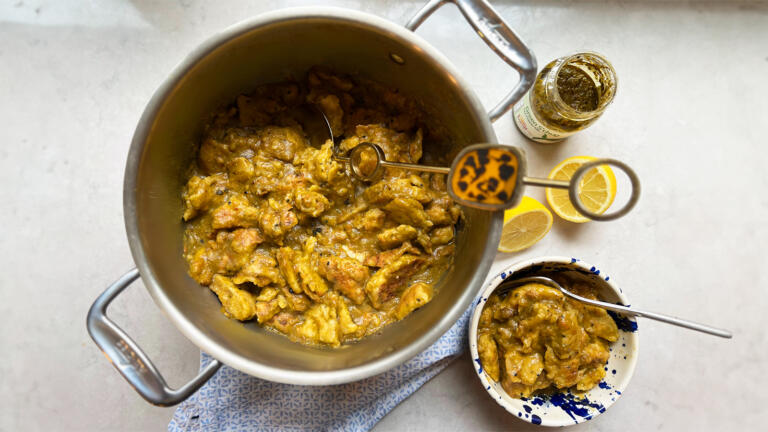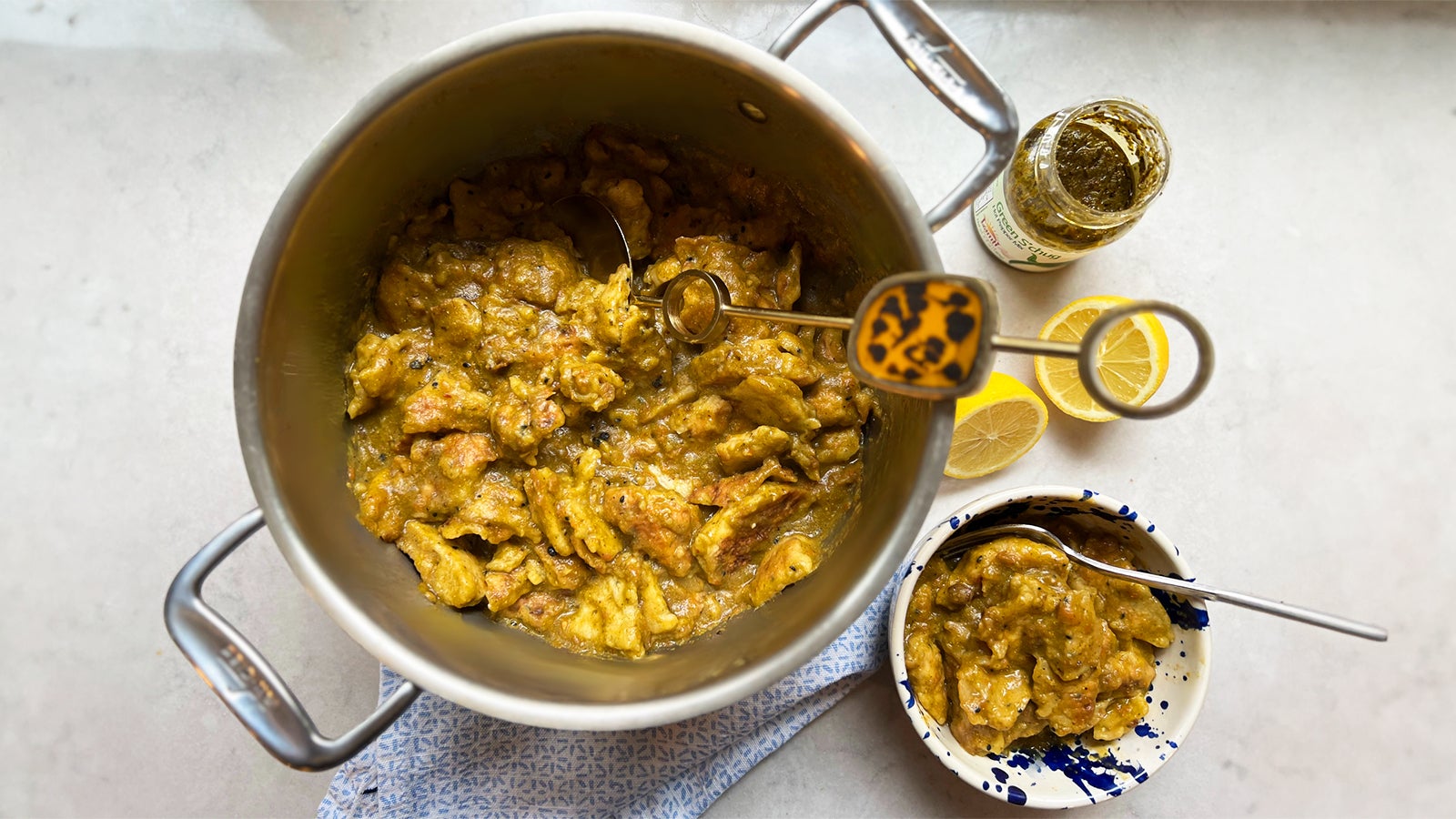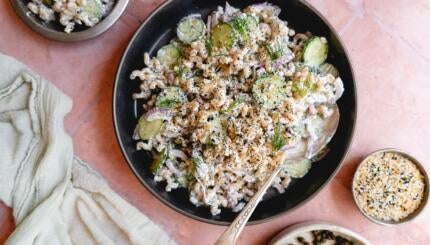Pini Amir, a Yemenite Jew from Beit Yitzhak in Israel, bakes some of the best flatbread I’ve ever tried: fluffy, thick Yemenite saluf dotted with nigella seeds. When fresh out of his backyard taboon (clay oven), charred here and there for extra flavor, the saluf is dipped in freshly whipped tahini sauce or the lemony juices of a chopped Israeli salad. And it’s simply sublime.
But for Pini, the best part of making his own saluf comes the next day, when the bread starts getting stale. That’s when he puts a large pot of chicken wings, marrow bones and root vegetables on the burner, covers it all with water and cooks a rich chicken soup. Once it’s ready, Pini takes just the broth and mixes in hilbeh (a Yemenite fenugreek condiment, recipe below) and spicy zhug, and crumbles in a large pile of dried saluf to soak it all up. This dish is called ftout, or fatout, and it’s been Pini’s favorite dish since childhood.
“In a way, ftout is really a verb, not a dish,” David Moshe told me from his home in Israel. Moshe is an Israeli with Yemenite roots, an eighth-generation jeweler and a cookbook author who specializes in Yemenite food.
Fatta (فتّ) in Arabic means “to crumble,” and in this context it means to crumble or break flatbread into small segments and soak in liquid. (The Hebrew word “ptit” means a crumb or morsel and comes from the same root. Ptitim, which is plural for ptit, is the Israeli name for Israeli couscous.)
The Nosher celebrates the traditions and recipes that have brought Jews together for centuries. Donate today to keep The Nosher's stories and recipes accessible to all.
The Yemenite Jewish ftout is really a part of a bigger family of dishes from the Arab world called fatteh or fatta. They all contain crumbled crispy, sometimes toasted, day-old flatbread that soaks up some of the liquid in a dish. The most popular is fattet hummus from the Levant, a dish of broken toasted pita that’s topped with freshly cooked chickpeas and yogurt and is served for breakfast. Other examples include fatta with eggplant or chickpeas and yogurt on top; with beef, lamb or chicken stews; and even with rice. The famous and delicious fattoush salad comes from the same family. Tharid is another type of fattah dish, popular in the Gulf. In this version, the bread plays a larger role and is topped with a rich vegetable and meat stew. According to the cookbook “Feat – Food of the Islamic World” by Anissa Helou, tharid was Prophet Muhammad’s favorite dish.
Fatteh are usually very homey and messy dishes, and are served within the family, not for guests. Using leftover stale bread instead of tossing it away makes these dishes, which are served all over the Middle East, from Saudi Arabia to Yemen, Egypt, Lebanon and Syria, smart both economically and environmentally.
In the Yemenite Jewish community, the beloved fatout/ftout has several variations. One popular version is made with samneh (fenugreek-spiced clarified butter), eggs and honey. The saluf is broken into pieces and fried in samneh, then mixed with eggs, and sometimes milk, and cooked. It is served with honey and a sprinkle of nigella seeds. Some people serve the dish for lunch before the pre-Yom Kippur meal (Seuda Mafseket). It is sometimes prepared with other Yemenite flatbreads like malawach or lachuh. During Passover, the dish is prepared with broken matzah instead, similar to the Ashkenazi matzah brei.
Fatta samneh, as the dish is called in Arabic, is still made in Yemen, with variations including chopped dates or bananas, making it a porridge-like breakfast. And since dishes morph and develop with time and change of location, you can find Israeli versions that omit the honey altogether, and mix in Edam-style grated cheese, or sprinkle with za’atar, turning it into a delicious savory omlet.
Another dairy version of ftout is a warm yogurt soup called zom: Yogurt is cooked with a little garlic and samneh, stale saluf is broken inside, and it is served with zhug and lemon. This dish is sometimes eaten after Yom Kippur for break the fast.
But the most famous version, and Pini’s favorite, is the one made with chicken or meat broth. The Yemenite cuisine is known for its soups and it’s only fitting that the Yemenite fatteh would be made with it as well. Just like the famous Yemenite bone marrow soup, available at Yemenite eateries throughout Israel, the soup for the ftout needs to be fatty and rich. That’s why Pini makes his soup with chicken wings, rich with fat from the skin, to which he adds marrow bones or beef chuck for extra flavor and fat.
Hilbeh, a popular condiment that is served with every Yemenite meal, is an important component in the ftout. To make it, ground fenugreek seeds are soaked in water overnight, when they become jello-like as they expand. The seeds are then whipped with spices, salt and lemon juice or vinegar. More elaborate versions include chili peppers or zhug, fresh cilantro and even tomato. It is addictive in its own right.
Pini mixes the rich clear broth with a lot of hilbeh, some grated tomatoes and cilantro. He adds a lot of zhug, because as a proud Yemenite he believes that spicy food is always better, and breaks all the stale saluf he has from the day before into the mixture. A few minutes of cooking together is all it takes, and the results, while some may say are not the best-looking, are so delicious, especially with a little lemon on top. For most of us, it’s a flavor combination we’re not familiar with, and I cannot recommend this enough.
Notes:
- Fenugreek seeds, preferably ground (not the dry leaves!) are available at most Middle Eastern supermarkets and online.
- A real shortcut would be to use a store-bought chicken broth. Just make sure to mix in some oil (olive oil is fine) or add some bone broth into the chicken broth so it is rich and fatty, as needed.
- Another major shortcut is to use store-bought flatbread instead of making your own saluf. Just be sure to use a thick flatbread, not the skinny pita bread available at most American supermarkets; look for Israeli-style pita bread (available at many Kosher supermarkets and some Whole Foods branches) or get Persian flatbreads from a Persian supermarket. (If you’re in Israel, any pita bread is fine.)
- You can use the hilbeh as a dip with pita bread. It keeps in the fridge in a sealed container for two days.
- Ftout keeps in the fridge for up to four days. Reheat in the microwave.

Yemenite Ftout Recipe
The ultimate Jewish comfort food.
- Total Time: 1 hour 35 minutes + overnight
- Yield: Serves 6
Ingredients
For the hilbeh:
- 1 Tbsp ground fenugreek seeds (see notes)
- ¾ cup water
- 1 bunch cilantro
- 1 leek, white and light green parts only, cut to 1-inch sections
- 1 ripe tomato, quartered
- 4 garlic cloves
- 1 Serrano pepper or any chili pepper, chopped
- juice from 1½ lemons (6 Tbsp)
- 1 tsp kosher salt
For the soup:
- 2 lb chicken wings
- 2–3 marrow bones or ½ lb beef chuck
- 1 medium yellow onion, peeled and quartered
- 1 carrot, peeled and cut to large chunks
- 1 celery stalk, cut to 2 inch sections
- 1 parsnip, peeled and cut to large chunks
- 1 bay leaf
- kosher salt
- ground black pepper
To assemble:
Instructions
- The night before, put ground fenugreek in a medium bowl and cover with ¾ cup water at room temperature. Cover with plastic wrap and let stand until the next day.
- To make the soup, put chicken wings, bone marrow and the vegetables in a large pot. Cover with water 1 inch over the ingredients and bring to boil over high heat. Skim the foam with a large spoon then add bay leaf, salt and black pepper to taste, reduce heat, cover the pot, and cook on low simmer for 1 hour. Taste and adjust salt. Keep only 2½ cups of the broth in the pot and keep the rest of the broth and chicken for another use. (For a shortcut, see notes.)
- In the meantime, make the hilbeh. The fenugreek you soaked last night will soak some of the water and become thick and jello-y. Put the soaked fenugreek and water in a blender and add the rest of the hilbeh ingredients. Blend until smooth and keep aside.
- Add all the hilbeh (about 2 cups) into the 2½ cups of clear broth in the pot and bring to boil on medium-high heat. Grate 2 tomatoes and add to the pot, together with zhug, if you want it to be spicy. Taste the soup and add salt and zhug to taste. Reduce heat to medium-low.
- Break the stale flatbread into 1 inch size pieces and drop into the soup. The flatbread should get a few inches above the soup, so when it soaks the soup, there will hardly be any liquid left. Mix the flatbread into the soup and cook for about 5 minutes, until it is all soaked in, and remove from the heat.
- Serve ftout while hot, with lemon wedges for everyone to squeeze on top of their serving.
Notes
- Fenugreek seeds, preferably ground (not the dry leaves!) are available at most Middle Eastern supermarkets and online.
- A real shortcut would be to use a store-bought chicken broth. Just make sure to mix in some oil (olive oil is fine) or add some bone broth into the chicken broth so it is rich and fatty, as needed.
- Another major shortcut is to use store-bought flatbread instead of making your own saluf. Just be sure to use a thick flatbread, not the skinny pita bread available at most American supermarkets; look for Israeli-style pita bread (available at many Kosher supermarkets and some Whole Foods branches) or get Persian flatbreads from a Persian supermarket. (If you’re in Israel, any pita bread is fine.)
- You can use the hilbeh as a dip with pita bread. It keeps in the fridge in a sealed container for two days.
- Ftout keeps in the fridge for up to four days. Reheat in the microwave.
- Prep Time: 15 minutes + soaking overnight
- Cook Time: 1 hour 20 minutes
- Category: Entree
- Method: Roasting
- Cuisine: Yemenite




Any chance you can get David Moshe to publish his Yemeni cookbooks in English. I only know of two books that contain only Yemeni recipes. I would love to add some to my collection.